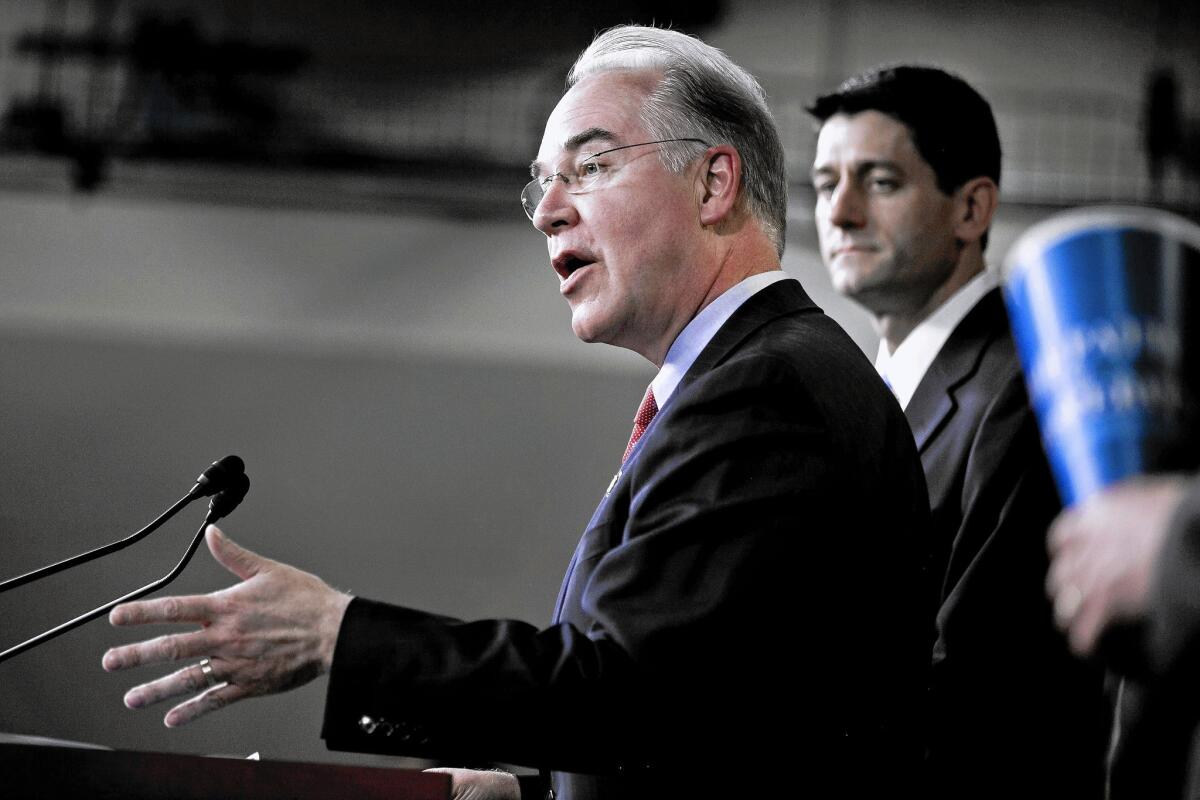House changes the way economic effect of major bills is calculated

Reporting from washington — House Republicans have changed the way that congressional number crunchers calculate the economic impact of major bills, a controversial step that should make it easier to cut taxes.
The move, part of a package of rules enacted as lawmakers began their new session this week, would require nonpartisan staff to use complex models in evaluating the effects on the economy of legislation with significant budgetary consequences.
Republicans have long wanted to make the change, which has been the subject of fierce debate among economists. Democrats contend that it masks the true costs of legislation.
But the November elections also gave the GOP control of the Senate, which is expected to adopt the new rules in the coming days as well.
The changes alter the way the staffs of the Congressional Budget Office and the Joint Committee on Taxation analyze bills and estimate their budgetary costs — a process known as scoring.
Since the process began in 1974, it has been a fairly straightforward calculation of how much more revenue a tax increase would produce or how much less a tax cut would trigger. But there normally has been no determination made of the effect on the overall economy.
The new rules call for a procedure known as dynamic scoring. It uses complicated economic models to try to determine “the budgetary effects of changes in economic output, employment, capital stock and other macroeconomic variables,” according to the rules package adopted by a 234-172 vote.
“What we are trying to do is simply say that if a piece of legislation is going to have a large effect on the economy, that we include that effect in the official estimate,” House Budget Committee Chairman Tom Price (R-Ga.) said.
Dynamic scoring estimates would be required on bills expected to have an effect on the federal budget of more than 0.25% of total economic output, or $42 billion based on the latest figures.
Supporters of dynamic scoring said the estimates show that tax cuts could stimulate revenue growth. But critics said the wide range of estimates demonstrate the difficulty in making such complicated projections.
Democrats strongly oppose dynamic scoring, saying it amounts to cooking the books to lessen the perceived budgetary effects of tax cuts.
It is based on what Democrats said was the flawed theory of “trickle-down economics,” which implies that tax cuts don’t increase the deficit because they generate more economic activity and therefore more tax revenue.
“What it means is the Republicans will be able to hide the true cost of tax cuts behind a debunked mantra that tax cuts pay for themselves,” said Rep. Steny H. Hoyer (D-Md.), the second-ranking House Democrat.
“They do not,” he said. “This provision will allow them to explode the deficit as they did the last time they were in charge.”
Although dynamic scoring has not been required previously, congressional staff have used it to make estimates for some bills to provide lawmakers with additional information on top of the standard budget score.
Last year, for example, the Joint Committee on Taxation provided a dynamic scoring estimate for a tax reform plan by then-Ways and Means Chairman Dave Camp (R-Mich.). The calculation used two models and a variety of economic assumptions.
The estimate said the plan, which included reducing the corporate rate to 25%, could increase tax revenue $50 billion to $700 billion over a decade, depending on which model was used.
Shaun Donovan, director of the White House Office of Management and Budget, said the change would require congressional staff to “make assumptions in areas with unusually great uncertainty.”
The Congressional Budget Office said it takes into account behavioral changes that could be caused by legislation. But the staff do not do broader dynamic scoring because “estimates of macroeconomic effects are highly uncertain.”
In 2013, the CBO included some dynamic scoring in its cost estimate for the bipartisan immigration overhaul that passed the Senate. The decision was made because the bill’s path to citizenship for about 11 million people in the country illegally would significantly increase the size of the U.S. labor force.
The CBO estimated that the legislation would reduce the budget deficit by $197 billion in its first decade and an additional $700 billion in the following decade.
As part of the shift to dynamic scoring, Republicans are likely to replace Douglas Elmendorf, the CBO’s head. He was appointed by Democrats in 2009 when they controlled both chambers of Congress. His term expired Saturday and many conservatives don’t want to reappoint him.
More to Read
Inside the business of entertainment
The Wide Shot brings you news, analysis and insights on everything from streaming wars to production — and what it all means for the future.
You may occasionally receive promotional content from the Los Angeles Times.










